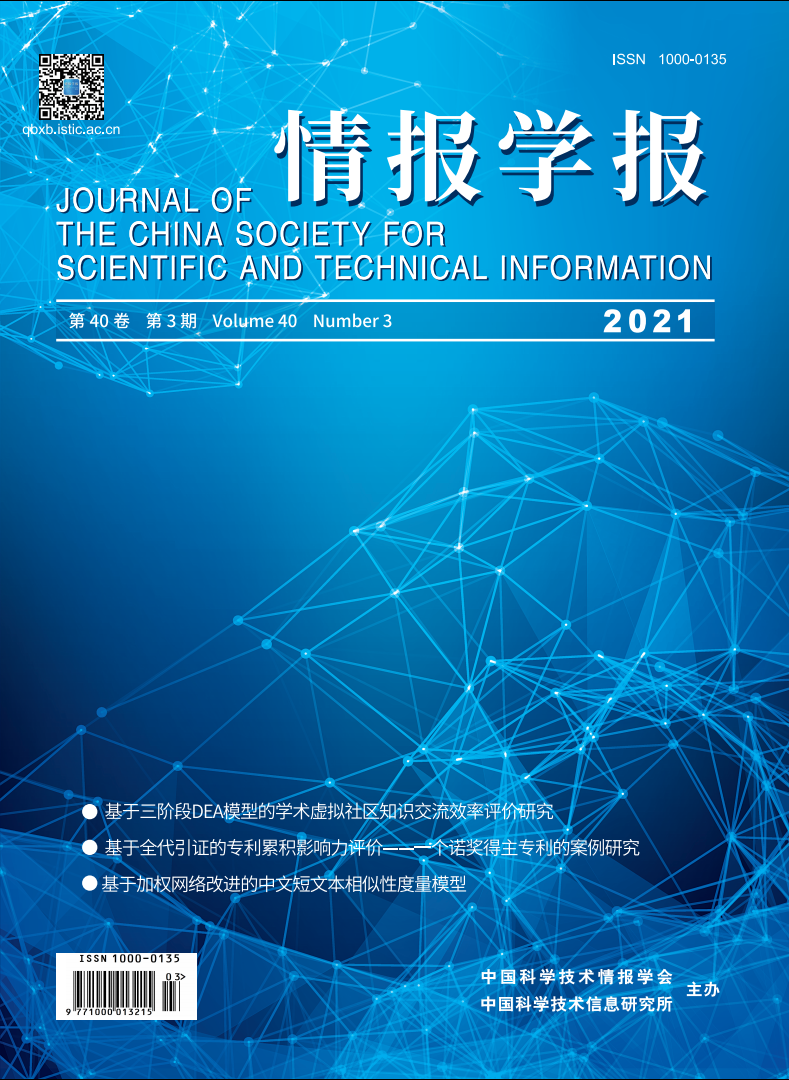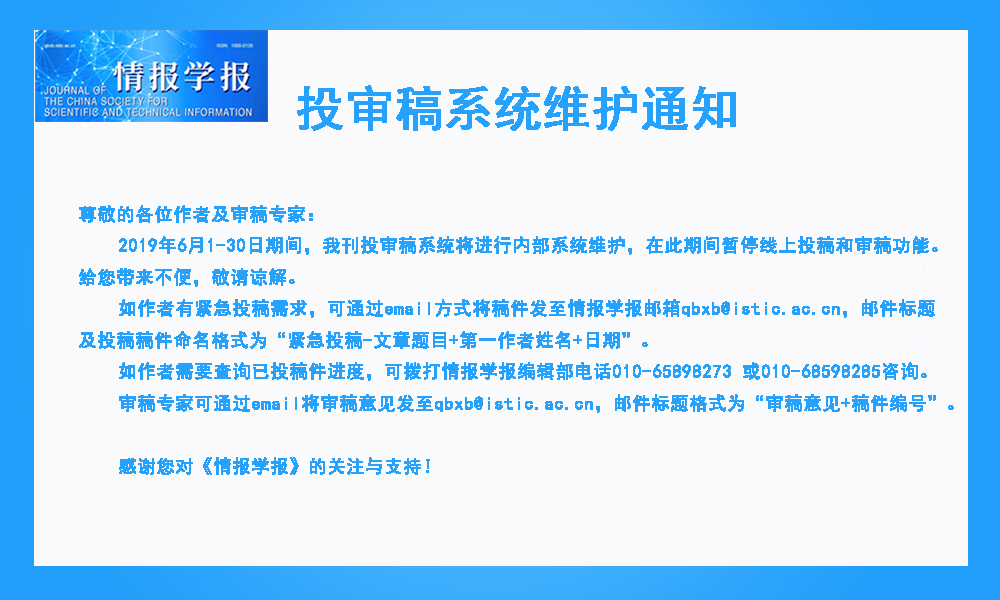 |
|
2021 Vol. 40, No. 3
Published: 2021-03-24 |
|
|
| |
|
|
|
|
|
234 |
Research on the Topic Clustering Graph and the Transmission Path of Micro-blogging Users amid COVID-19 Based on the LDA Model Hot! |
|
 |
Zhang Liu, Wang Xiwei, Huang Bo, Liu Tingyan |
|
|
DOI: 10.3772/j.issn.1000-0135.2021.03.002 |
|
|
The topic clustering graph of micro-blogging users of the “Japan Diamond Princess” based on the Latent Dirichlet Allocation (LDA) model can more accurately and effectively identify the topic characteristics and opinion leaders of micro-blogging users. Further, it can analyze the topic transmission path between network communities during the pandemic, thereby helping the public opinion supervision department conduct more effective guidance and supervision of public opinion. Based on the LDA model, this paper builds the topic clustering graph of micro-blogging users amid the COVID-19 pandemic. In doing so, it uses the perplexity evaluation index to determine the optimal number of topics and their distribution for micro-blogging users, and uses the network users to forward comments to build a micro-blogging user topic cluster graph. Additionally, it puts forward the analysis method of the topic transmission path among the network communities, combined with the topic of public opinion during the global COVID-19 pandemic, the “Japan Diamond Princess.” Thus, this study aims to determine the topic of the micro-blogging user group, identify the subject opinion leaders, and analyze the topic transmission path among network communities under this topic. The research results show that based on the LDA model, it is possible to identify the topic of the online community and discover the derived public opinion topics. Through the identification of opinion leaders, it is possible to guide public opinion more efficiently. Through the analysis of the topic transmission path of the online community and topic push, the better guidance of public opinion and network ecological governance can be achieved. |
|
|
2021 Vol. 40 (3): 234-244
[Abstract]
(
378
)
HTML
(120 KB)
PDF
(6331 KB)
(
1289
) |
|
|
|
245 |
Research on the Characteristics of the Participants of Information Dissemination during the COVID-19 Pandemic —A Case Study of “Diamond Princess” Hot! |
|
 |
Wang Xiwei, Jia Ruonan, Liu Tingyan, Zhang Liu |
|
|
DOI: 10.3772/j.issn.1000-0135.2021.03.003 |
|
|
COVID-19 has been designated by the World Health Organization (WHO) as a public health emergency of international concern (PHEIC). It has received widespread global attention, triggering the dissemination of a large amount of information on global social media platforms. The analysis of the characteristics of the main body of information dissemination in public health emergencies is an important issue. As such, the government supervision and guidance departments consider this issue in the Internet public opinion guidance and network ecological governance of the pandemic. We conducted the characteristic analysis method and the analysis model of the participants during the COVID-19 pandemic, and combined the results with the typical topic of “Diamond Princess” during the global pandemic on the Sina Weibo platform. In doing so, we performed an analysis of the participation time, influence, and features of the content of the participants. The results showed that there are obvious differences in the participation time of different subjects; the overall influence of online official media is the strongest, and the influence of the subjects changes dynamically with time. Further, the content of online official media and self-media is clear, and the content types that ordinary netizens consider are numerous and varied. |
|
|
2021 Vol. 40 (3): 245-255
[Abstract]
(
418
)
HTML
(104 KB)
PDF
(9185 KB)
(
339
) |
|
|
|
256 |
An Evaluation of the Knowledge Exchange Efficiency of an Academic Virtual Community Based on a Three-Stage DEA Model Hot! |
|
 |
Yang Ruixian, Huang Shurui, Yu Zhengjie |
|
|
DOI: 10.3772/j.issn.1000-0135.2021.03.004 |
|
|
The purpose of this paper is to analyze the influence of environmental factors on the efficiency of knowledge exchange in academic virtual communities based on an analysis of the impact of exogenous factors. It also provides a reference for further objective evaluation of the knowledge exchange efficiency of academic virtual communities. The method is based on a three-stage Data Envelopment Analysis (DEA) model and uses the organic communication, first principles, micron and nano, and financial investment sections of the Little Woodworm Forum as examples and reports the changes in the efficiency of community knowledge exchange. The study shows that after excluding the influence of exogenous factors, the knowledge exchange efficiency of the academic virtual community improved; however, the decision making unit (DMU) was still not effective. The results for the first and third stage show that the knowledge exchange efficiency of the first-principles section was the highest. The influence of environmental variables on the knowledge exchange efficiency of academic virtual communities such as the number of loose funds, the total number of users’ posts, the participation of community managers, and the quality of community members had a positive effect on the knowledge exchange efficiency of such communities. Factors such as the number of online users had a negative impact on the efficiency of community knowledge exchange. |
|
|
2021 Vol. 40 (3): 256-266
[Abstract]
(
324
)
HTML
(168 KB)
PDF
(1715 KB)
(
655
) |
|
|
|
286 |
Artificial Intelligence Technology: Novel Strategy for Patent Dataset Creation Based on Machine Learning Hot! |
|
 |
Chen Yue, Song Kai, Liu Anrong, Cao Xiaoyang |
|
|
DOI: 10.3772/j.issn.1000-0135.2021.03.007 |
|
|
Disruptive technology is a technology group with a complex internal structure that spans multiple disciplines and fields, and from a spatial perspective, it includes leading, auxiliary, and supporting technologies. The use of scientometrics to evaluate disruptive technologies and explore the evolution of science and technology is facing challenges that manifest in data retrieval. This paper explores a novel strategy for patent dataset construction for complex technology based on machine learning, with a focus on the patent retrieval tasks (binary classification tasks) of machine learning. This is similar to query classification, which is based on active learning in information retrieval. Additionally, we propose an improved text classification method that combines feature maximization with the CNN model. In this paper, the technical domain of artificial intelligence (AI) is used as an example. The results show an accuracy of 98.01%, a recall rate of 97.04%, and an F1 value of 97.89%; this demonstrates that the proposed strategy accurately identifies AI patents, improves the accuracy and recall rate of patent searches, and facilitates the creation of accurate and comprehensive patent datasets for the technical domain of AI. |
|
|
2021 Vol. 40 (3): 286-296
[Abstract]
(
521
)
HTML
(116 KB)
PDF
(3947 KB)
(
1707
) |
|
|
|
297 |
Analysis Framework for the Evolution of Scientific Themes from a Multi-Dimensional Perspective Hot! |
|
 |
Wang Kang, Chen Yue, Su Cheng, Zhao Xiaoyuan |
|
|
DOI: 10.3772/j.issn.1000-0135.2021.03.008 |
|
|
This article is based on knowledge measurement theory regarding the dissociation and combination of knowledge units. Keywords were extracted after time-weighted correction and used as knowledge units. Analysis was based on the theory of scientific theme evolution, occurring at three levels—keyword, keyword association, and topic association framework—and involved measures of time-weighted word frequency, keyword-related topics, and topic-related similarity. The subject of this case study was the core paper for big data research in the field of library and information sciences. Experimental results show that time-weighted keyword frequency measurement strengthens rising keywords, weakens falling keywords, and quickly detects absolute high-frequency words, emergent words, or emerging words. Topic measurement based on keyword associations allows researchers to have an overall perception of and to predict development trends in big data topics in the field of library and information sciences. The similarity measure, which is based on topic association, demonstrates the complex relationships of fusion, diffusion, emergence, and extinction between various topics, which helps reveal research hotspots in the field and predicts future development trends. |
|
|
2021 Vol. 40 (3): 297-307
[Abstract]
(
319
)
HTML
(137 KB)
PDF
(5974 KB)
(
928
) |
|
|
|
308 |
Study of User Information Requirements in an Online Health Community Based on the Distribution of User Profile and Theme Features: Taking Colorectal Cancer Data from YiXiang as an Example Hot! |
|
 |
Sheng Shu, Huang Qi, Zheng Shuya, Yang Yang, Xie Qiwen, Zhang Ge, Qin Xinguo |
|
|
DOI: 10.3772/j.issn.1000-0135.2021.03.009 |
|
|
In this study, the user information requirements of an online health community were constructed based on user profiles and theme feature extraction to reveal user behavioral rules and characteristics of different types of user groups in different roles, providing the basis for promoting the development of an online health community. Python was used to obtain user data from the colorectal cancer circle of the YiXiang community. Future typical user identification metrics were constructed taking three characteristics into account: user role attributes, user behavior attributes, and text features. These three characteristics were combined with a theme classification system to build the user profile concept model. The user group was divided into four categories, and the user behavior recognition algorithm and theme clustering algorithm were used to identify each user’s interest content in different roles and obtain an accurate picture of the user requirements. By mining and analyzing differences in gender, age, and theme distribution among the four types of user roles, we found that there are significant differences in information requirements among different user groups. |
|
|
2021 Vol. 40 (3): 308-320
[Abstract]
(
504
)
HTML
(157 KB)
PDF
(3037 KB)
(
1537
) |
|
|
|
321 |
Development and Innovation of Information Science in the Era of Artificial Intelligence: From the Perspective of Information Communication Theory Hot! |
|
 |
Ding Botao |
|
|
DOI: 10.3772/j.issn.1000-0135.2021.03.010 |
|
|
In this paper, the innovation and development of Information Science in the artificial intelligence era are discussed comprehensively and systematically. First, based on the theory of information exchange, this paper reviews the historical development stages of information science: the era of big science, big information, big knowledge, big data, and big intelligence. Second, this paper analyzes the evolution of information exchange theory in the artificial intelligence era, including the virtualization of communication subject, the intellectualization of communication content, and the unconsciousness of communication process. It also analyzes the development of Information Science from three dimensions, including the return of intelligence analysis, Information Engineering, and the improvement of the importance of open source intelligence. The analysis of information exchange theory, information discipline system, and information work in this paper not only helps to provide some new ideas for the innovation and development of information theory in the new technological environment, but also provides inspiration for the intelligent innovation of the information system and information service. |
|
|
2021 Vol. 40 (3): 321-332
[Abstract]
(
573
)
HTML
(119 KB)
PDF
(1896 KB)
(
2268
) |
|
|
|


